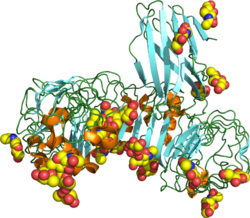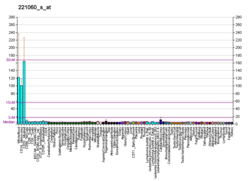
Back TLR4 Czech TLR4 Welsh TLR4 Persian TLR4 French TLR4 Japanese TLR4 Korean TLR4 Dutch TLR4 Polish TLR4 Portuguese Толл-подобный рецептор 4 Russian
Toll-like receptor 4 (TLR4), also designated as CD284 (cluster of differentiation 284), is a key activator of the innate immune response and plays a central role in the fight against bacterial infections. TLR4 is a transmembrane protein of approximately 95 kDa that is encoded by the TLR4 gene.
TLR4 belongs to the toll-like receptor family which is representative of the pattern recognition receptors (PRR), so named for their ability to recognize evolutionarily conserved components of microorganisms (bacteria, viruses, fungi and parasites) called pathogen-associated molecular patterns (PAMPs). The recognition of a PAMP by a PRR triggers rapid activation of the innate immunity essential to fight infectious diseases.[5]
TLR4 is expressed in immune cells mainly of myeloid origin, including monocytes, macrophages and dendritic cells (DC).[5] It is also expressed at a lower level on some non-immune cells, including epithelium, endothelium, placental cells and beta cells in Langerhans islets. Most myeloid cells express also high amounts of plasma membrane-anchored CD14, which facilitates the activation of TLR4 by LPS and controls the subsequent internalization of the LPS-activated TLR4 important for receptor signaling and degradation.[6][7]
The main ligands for TLR4 are lipopolysaccharides (LPS), the major components of the outer membrane of Gram-negative bacteria and some Gram-positive bacteria. TLR4 can also be activated by endogenous compounds called damage-associated molecular patterns (DAMPs), including high mobility group box protein 1 (HMGB1), S100 proteins, or histones. These compounds are released during tissue injury and by dying or necrotic cells.[8][9][10][11][12]
- ^ a b c GRCh38: Ensembl release 89: ENSG00000136869 – Ensembl, May 2017
- ^ a b c GRCm38: Ensembl release 89: ENSMUSG00000039005 – Ensembl, May 2017
- ^ "Human PubMed Reference:". National Center for Biotechnology Information, U.S. National Library of Medicine.
- ^ "Mouse PubMed Reference:". National Center for Biotechnology Information, U.S. National Library of Medicine.
- ^ a b Vaure C, Liu Y (2014). "A comparative review of toll-like receptor 4 expression and functionality in different animal species". Frontiers in Immunology. 5: 316. doi:10.3389/fimmu.2014.00316. PMC 4090903. PMID 25071777.
- ^ Mahnke K, Becher E, Ricciardi-Castagnoli P, Luger TA, Schwarz T, Grabbe S (1997). "CD14 is Expressed by Subsets of Murine Dendritic Cells and Upregulated by Lipopolysaccharide". In Ricciardi-Castagnoli P (ed.). Dendritic Cells in Fundamental and Clinical Immunology. Advances in Experimental Medicine and Biology. Vol. 417. Boston, MA: Springer US. pp. 145–159. doi:10.1007/978-1-4757-9966-8_25. ISBN 978-1-4757-9968-2. PMID 9286353.
- ^ Sabroe I, Jones EC, Usher LR, Whyte MK, Dower SK (May 2002). "Toll-like receptor (TLR)2 and TLR4 in human peripheral blood granulocytes: a critical role for monocytes in leukocyte lipopolysaccharide responses". Journal of Immunology. 168 (9): 4701–4710. doi:10.4049/jimmunol.168.9.4701. PMID 11971020.
- ^ Yang H, Wang H, Ju Z, Ragab AA, Lundbäck P, Long W, et al. (January 2015). "MD-2 is required for disulfide HMGB1-dependent TLR4 signaling". The Journal of Experimental Medicine. 212 (1): 5–14. doi:10.1084/jem.20141318. PMC 4291531. PMID 25559892.
- ^ Jiang D, Liang J, Fan J, Yu S, Chen S, Luo Y, et al. (November 2005). "Regulation of lung injury and repair by Toll-like receptors and hyaluronan". Nature Medicine. 11 (11): 1173–1179. doi:10.1038/nm1315. PMID 16244651. S2CID 11765495.
- ^ Fang H, Ang B, Xu X, Huang X, Wu Y, Sun Y, et al. (March 2014). "TLR4 is essential for dendritic cell activation and anti-tumor T-cell response enhancement by DAMPs released from chemically stressed cancer cells". Cellular & Molecular Immunology. 11 (2): 150–159. doi:10.1038/cmi.2013.59. PMC 4003380. PMID 24362470.
- ^ Hernandez C, Huebener P, Schwabe RF (November 2016). "Damage-associated molecular patterns in cancer: a double-edged sword". Oncogene. 35 (46): 5931–5941. doi:10.1038/onc.2016.104. PMC 5119456. PMID 27086930.
- ^ Jang GY, Lee JW, Kim YS, Lee SE, Han HD, Hong KJ, et al. (December 2020). "Interactions between tumor-derived proteins and Toll-like receptors". Experimental & Molecular Medicine. 52 (12): 1926–1935. doi:10.1038/s12276-020-00540-4. PMC 8080774. PMID 33299138.
© MMXXIII Rich X Search. We shall prevail. All rights reserved. Rich X Search





